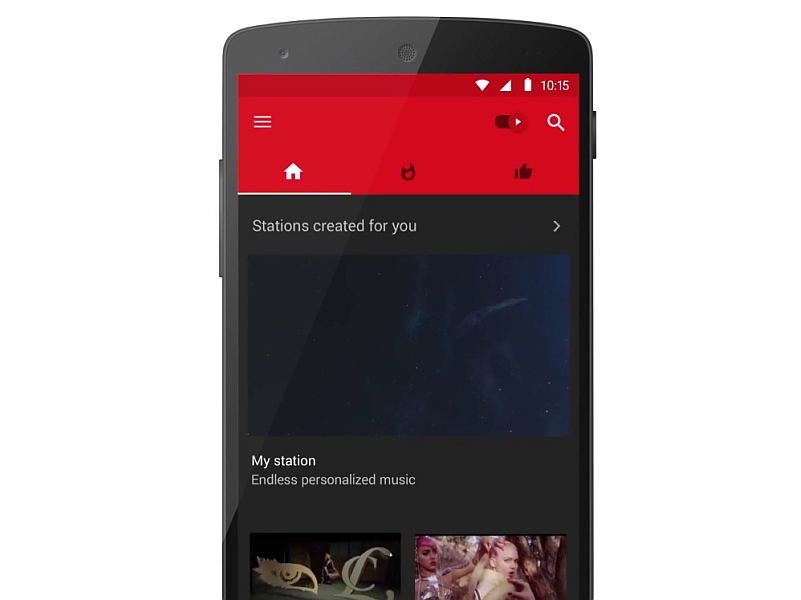YouTube on Thursday entered the increasingly crowded field of music
streaming, hoping to reach a new audience through a user-friendly
service that seizes on the video giant's vast variety.
Called
YouTube Music, the platform will offer songs both with and without
video, and users will be able to switch instantly to an audio-only mode.
In
a feature it hopes will be a key selling point, YouTube Music will
create non-stop stations tailored to users, who can fine-tune how much
variety they want.
YouTube, the world's third most popular website
after its parent company Google and Facebook, aims to take advantage of
its quirky possibilities by offering artists' original tracks alongside
cover versions, live footage and user-generated content.
T. Jay
Fowler, the director of product development who was involved in earlier
services Beats Music and MOG, said he hoped to draw more people to
streaming instead of simply competing with other companies.
"I'm excited about being additive to the market, rather than just moving users through an ecosystem of apps," he told AFP.
Not just videos
The video behemoth on October 28 launched YouTube Red, a premium service that allows advertisement-free access to subscribers.
YouTube
Music - which was announced alongside YouTube Red without full details
or a launch date - is compatible both with Google's Android system (Google Play) and
Apple (App Store) and will initially be available only in the United States.
The
streaming service will be free but will come without advertisements for
subscribers to YouTube Red, which costs $9.99 a month.
Google
will still operate its audio-driven Google Play Music streaming service,
with YouTube Music expecting some consumers to use both platforms.
Streaming
-- which allows unlimited online music on-demand -- has been rapidly
growing. Universal Music Group, the largest label conglomerate, said
Tuesday that for the first time more than half its digital revenue came
from streaming in the latest quarter.
Spotify is by far the
largest streaming company with 75 million users, 20 million of them
paying. But it has faced growing competition from new entrants Apple
Music and rap mogul Jay Z's Tidal, which have both tried to distinguish
themselves through original content and video.
YouTube in turn learned that it needed to focus less exclusively on video during a trial phase known as YouTube Music Key.
Listeners wanted to turn off videos when driving or exercising for fear of using up their batteries or data allotments.
"It really comes down to portability, and I think to date YouTube has not been seen as a portable experience," Fowler said.
Reaching non-music buffs
While
YouTube Music will highlight rising new artists, the service is largely
targeting the casual fan who may have been listening to the same songs
for years.
"The magic of YouTube is this massive catalog," Fowler said, but added that the main message was "low-effort, high-reward."
"The
majority of people who are consuming music in the United States right
now consume it in the car and are listening to a highly repetitive set
of music," he said.
"I want to remind users that music has intrinsic value and that it's worth paying for," he said.
Listeners can tap on a favorite artist and then listen to a continuous selection of music generated for them.
Users
can fine-tune their channels by clicking thumbs up or thumbs down on
tracks and adjusting filters on how adventurous they want to be.
Going
one step further with portability, YouTube Music will constantly cache
tracks so that a user can come back while offline -- a feature that is
possible but not automatic on most streaming services.
Streaming, despite its growth, has come under fire from a number of artists who say that the proceeds are paltry.
Even
before its entry into streaming, YouTube has been a frequent target of
music industry representatives alarmed by users' ability to post nearly
anything online.
YouTube said it was committed to proper payments.
In a blog post announcing YouTube Music, it said that YouTube and
Google have paid more than $3 billion to the music industry.
 Google Play Store Blocks 17 Unregistered Crypto Exchanges in South Korea, Apple May Follow27 March 2025
Google Play Store Blocks 17 Unregistered Crypto Exchanges in South Korea, Apple May Follow27 March 2025 Google's Android OS Will Reportedly Be Developed Privately as Company Shifts Strategy27 March 2025
Google's Android OS Will Reportedly Be Developed Privately as Company Shifts Strategy27 March 2025 Android 16 Developer Preview 3 Reportedly Enables Screen-Off Fingerprint Unlock on All Pixel Phones24 March 2025
Android 16 Developer Preview 3 Reportedly Enables Screen-Off Fingerprint Unlock on All Pixel Phones24 March 2025 WhatsApp Reportedly Developing AI-Powered Rewrite Feature, Two-Way Voice Chats with Meta AI21 March 2025
WhatsApp Reportedly Developing AI-Powered Rewrite Feature, Two-Way Voice Chats with Meta AI21 March 2025 Netflix Announces Spirit Crossing, a 'Cozy MMO' Coming to Netflix Games in 202521 March 2025
Netflix Announces Spirit Crossing, a 'Cozy MMO' Coming to Netflix Games in 202521 March 2025



![Gadgets 360 With Technical Guruji: News of the Week [March 29, 2025]](https://c.ndtvimg.com/2025-03/9cu1890s_news-of-the-week_160x120_29_March_25.jpg?downsize=180:*)










